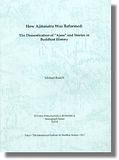How Ajatasatru was reformed
Radich, Michael:
How Ajātaśatru was reformed : the domestication of "Ajase" and stories in Buddhist history / Michael Radich. - Tokyo : International Institute for Buddhist Studies of the International College for Postgraduate Buddhist Studies, 2011. - iii, 202 S. - (Studia philologica Buddhica : Monograph series ; 27)
ISBN 978-4-906267-65-1
YEN 800,00
DDC: 294.3092
Beschreibung
Ajātaśatru is famous in Buddhist literature for having killed his father, Bimbisāra, in order to come to the throne. This study traces the development of this story in Indian, Chinese and Japanese sources, from canonical Mainstream Buddhism to the modern era. Over the course of that long history, this story was transformed many times, a process that culminated in perhaps the most startling transformation of all – the elaboration of the modern psychoanalytic theory of a psychological complex named after Ajātaśatru by Kosawa Heisaku and Okonogi Keigo (the "Ajase Complex"), and the attendant reinvention of Ajātaśatru as "Ajase". Particular attention is given in this study to connecting transformations in the Ajātaśatru narrative to features of the cultural context at two key junctures in its history – in China in the fifth and sixth centuries, and in modern Japan. The study is also presented as an attempt to model ways of using narrative materials as windows into the historical Buddhist worlds they traveled through, and that shaped them. Another dimension of the study that should be of particular interests to Buddhologists is the links between certain texts in Buddhist literature revealed by the narrative and its transformations, particularly among members of a group of texts related to the Mahāyāna Mahāparinirvāṇa sūtra. More generally, the book should be relevant to readers in Buddhist Studies, medieval Chinese studies, Japanese cultural studies, and psychoanalytic theory and its history.
Inhalt
Acknowledgements. i
Abbreviations. iii
1. Introduction: How an Ancient Indian Patricide Usurper Turned into a Modern Japanese Mummy's boy. 1
2. Ajātaśatru in India: The Drama Begins to Take Shape. 6
3. Between India and China: The Mahāparinirvāṇa and Contemplation sūtras. 33
4. The Making of the Chinese Ajātaśatru. 48
5. Chasing the White Rabbit: New Twists on Ajātaśatru in Medieval China. 62
6. Shinran and the "Rootless Faith": Ajātaśatru in Kamakura Japan. 77
7. Ajātaśatru Meets Snow White: Between Shinran and Japanese Modernity. 83
8. Ajātaśatru Meets Freud: Kosawa and Okonogi's "Ajase". 88
9. The Making of the Japanese "Ajase". 105
10. Conclusions: How Stories Have Been Told in Buddhist History, and What We Can Learn from Them. 127
APPENDICES
1. Primary sources of the Ajātaśatru narrative. 138
2. Further exploits of Ajātaśatru in other texts. 143
3. The many names of Ajātaśatru. 147
4. The Mahāparinirvāṇa sūtra and the Mūlasarvâsativāda vinaya: Hidden links between India and China. 160
5. The close affinity of the Mahāparinirvāṇa sūtra with the *Ekottarikâgama. 164
6. A cluster of stories as further evidence of links between MPNS and Sarvâstivāda sources. 167
Bibliography. 171
Index. 187
Autor
MICHAEL RADICH, School of Art History, Classics and Religious Studies, University of Wellington, Victoria, New Zealand. Profile page.
Quellen: International College for Postgraduate Buddhist Studies (国際仏教学大学院大学); WorldCat; Mitteilung von Charles Muller, Mailing-Liste H-Buddhism, 1. April 2011
Ähnlich
- Therigatha
- Women in Early Indian Buddhism
- Rakow: Transformationen des tibetischen Buddhismus
- De Chiara: The Khotanese Sudhanāvadāna ... 2
- Tiso: Liberation in One Lifetime
- Dalai Lama V.: The Illusive Play
- Vinaya Texts
- Bhikkhu-Vibhanga
- Marciniak: Studia nad Mahavastu
- Schmithausen: The Genesis of Yogācāra-Vijñānavāda

